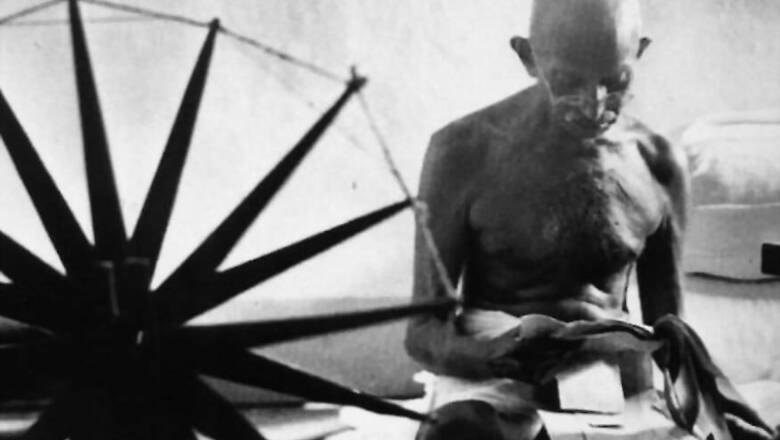
views
New Delhi: This is where Mohandas Karamchand Gandhi breathed his last, falling to the ground with a gentle “Hey Ram” on his lips as Nathuram Godse fired three bullets into him, and from where Jawaharlal Nehru echoed the grief of a nation with his words, “The light has gone out of our lives.”
Seventy-one years after that January 30 sunset as India and the world celebrate Gandhi’s 150th birth anniversary, Gandhi Smriti where he died is where the Mahatma still lives.
The sparkling white walls and the expansive grounds of what was then known as Birla House encapsulate within it the history of Mahatma Gandhi. And somewhere, in the chattering crowds of tourists and schoolchildren, even the spirit of the man who engineered India’s freedom with his steadfast belief in non-violence.
A stroll down Tees January Marg, the leafy avenue in Lutyens Delhi named after the day Gandhi was assassinated, leads to the sprawling Birla House where ‘Bapu’ spent his last 144 days before being felled while he was on his way to his evening prayers.
At the Martyr’s Column, the spot where he collapsed, 12-year-old Yuvraj and his friend lean towards the plaque with the words “Hey Ram”. A moment later, it strikes the young student that this is where the father of the nation said his last words.
“Hey look! This is the place where Godse shot Gandhi ji. Aren’t these the words he said before dying?” Yuvraj tugs at his friend and points to the column excitedly.
The student from Bal Bharati Public School, Pitampura, was among the hundreds of school children at Gandhi Smriti, ahead of Gandhi’s 150th birth anniversary on October 2.
Asked what they knew about the place, the students chime in together, but not in a comprehensible sequence of events.
“Gandhi ji lived here. And he was shot here on this road. He was late for his prayers. And he wrote 1,000 letters a day,” said Yuvraj.
Cemented footsteps retrace Gandhi’s last walk to the place where Godse was waiting for him, touching his feet before assassinating him.
Shortly after, Nehru wept as he told the nation from the gates of Birla House in what is believed to be one of the greatest speeches of the world, “The light has gone out of our lives and there is darkness everywhere…”
Converted into a national memorial in 1973, the Gandhi Smriti complex today preserves the room where Gandhi stayed, long galleries filled with his photographs and letters depicting important events of his life, and a multimedia museum with interactive instruments.
His room has been preserved as it was on the day he stepped out for what would be his last walk his glasses, walking stick, a fork and spoon, the mattress on the floor he slept on and a well-thumbed copy of the Gita tell visitors the tale of the man whose life inspired so many, and continues to do so.
On her first day visiting the country, Mia from China found Gandhi Smriti to be the perfect resting place for “such an important person”.
“I like it very much, it is so calm and quiet. His influence on people is visible from this place,” she said.
After pondering for a few moments, another tourist Willa added, “It is very educational.”
Bayram, a tourist from Turkey, was surprised to know on his tour itinerary that this was Gandhi’s last place. But Martin Nyberg from Sweden, who travelled solo to Delhi, had planned his visit to the place.
“I had read about this place and wanted to see it on my own. He was an important man and this memorial kind of sums up his contribution and teachings,” Nyberg said.
While Gandhi Smriti is part of many tourist itineraries, for Ashish Meena, a student at Dyal Singh College, it was another day exploring the city.
The impromptu visit, he said, has opened his eyes.
“Coming here and seeing the documents, letters, and his way of life made it clear how much misinformation is being spread about Gandhi,” the economics honours student said.
According to Sushmita Bharali, project manager of the Eternal Gandhi multimedia museum, college and school students, foreigners visit throughout the year.
“Most locals associate Raj Ghat as the place where Gandhi was assassinated. It is unfortunate that they are not aware,” Bharali said.
The multimedia section is a big hit among tourists and students, she said.
Citing the example of a Japanese tourist, who was surprised to see the interactive technology used in some of the installations, Bharali said visitors love to learn about Gandhi through modern means.
The Time Line Browser installed on one of the walls allows visitors to see the leader’s life in chronological order, “From Mohandas to Mahatma”, through a horizontally moving tablet.
Another installation, an e-train, allows one to trace Gandhi’s journey in India and the significance of the places he visited.
Similarly, an e-prison shows glimpses of Gandhi’s life spent behind bars.
Inside the complex, it is all about Gandhi’s teachings and his principles.
Outside the gate, a small-time vendor selling statues of three monkeys representing Gandhi’s principles of see no evil, speak no evil, hear no evil is not too happy.
“We barely make any sale, moreover, we are threatened everyday to remove our shop. You think Gandhi would have wanted that?” he poses the question before turning to his probable customers.
Read all the Latest News, Breaking News and Coronavirus News here. Follow us on Facebook, Twitter and Telegram.


















Comments
0 comment